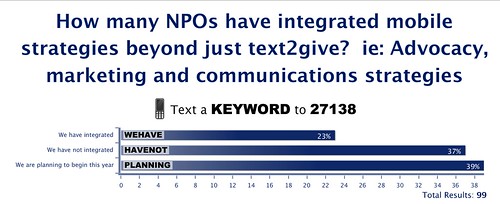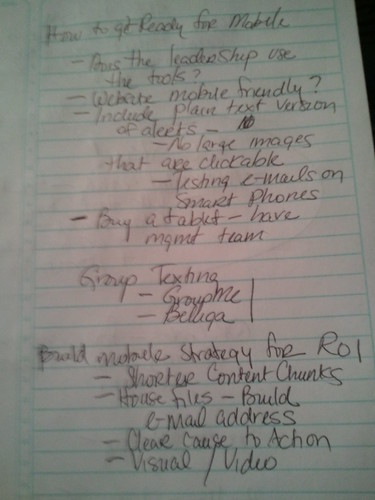
I’m at the Innogive 2011 Conference today. The focus is on Mobile Giving. The format is a mix of Ted style presentations and interactive panel discussions. I just finished moderating a panel on the topic of social and mobile integration. Here’s the description:
Where and how do mobile and social strategy intersect. How do you combine mobile with the grassroots power of social media to successfully engage donors. Can mobile drive volunteers activists, to engage across other media channels? What is the key to a viral campaign which combines these outreach tools.
The panelists included my business partner at Zoetica, Geoff Livingston; Allyson Kapin, RAD Campaign; and Stephen Wright Grameen Foundation. Here’s a summary of the highlights of the conversation:
Before I dive into the content, I had the pleasure of experimenting with a text polling app to find out the composition of the audience and their experience with the panel topic. In this case, we were talking about how to integrate the use of mobile technology into multi-channel campaigns with an emphasis on social.
It was powerful to watch the poll results come in live on the screen. One thing I learned is that there is a bit of delay so you can’t announce the final results until everyone has texted. We had a 50% response rate. So, while we were waiting, I asked the panelists to take bets.
We started off with the question of why nonprofits must attention to mobile and integrate it into their communications tool box. I asked the panelists how they would justify mobile to an executive director if they were the a staff member at nonprofit.
Already that morning, keynotes had give some powerful adoption statistics. For example, 13% of handhelds are smartphones, but account for 78% of data traffic and there are 180 billion text messages monthly. Geoff Livingston gave an overview of mobile trends, mentioning that the adoption rate of mobile phones and tablets are higher than Twitter now and mobile is now part of our lives. Allyson Kapin shared some stats about the use of email on mobile devices.
Geoff Livingston recommended that in addition nonprofits look at their web site analytics, google analytics for example can tell the percentage of referral traffic. If you have more than 20%, you need to think about making your site mobile friendly.
Steve Wright spoke about the need to make the argument to senior leadership and help them explore and get their hands on the mobile technology. He also added that you need to demonstrate the usefulness. If all else fails, the message should be that the organization risks being irrelevant to its stakeholders. As the morning keynote presenter Major George Hood, Salvation Army said, “Everything will happen in the palm of your hand. Mobile is where you need to be.”
Steve Wright, a self-confessed obsessive user of the smart phone, emphasized that mobile is now part of the consumer landscape. He observed that he engages with causes he cares about via his phone through Causes and Facebook, but many nonprofit web sites are not yet “mobile ready.” According to this recent nonprofits and mobile survey summarized on the NTEN Blog, only 16% of the surveyed nonprofits plan on having mobile websites in 2011 compared to 90% of surveyed nonprofits use email marketing and social media in their engagement strategies.

We discussed nonprofit readiness for integrating a mobile strategy. Nonprofits need two things: engagement strategy and to think differently about content. Geoff Livingston emphasized that different media forms mandate different types of content — and nonprofits must consider this as part of the online content strategy. People who reading content on their smartphones or tablets will not be consuming text heavy information – it has to brief text and visual or videos.
Panelists recommend that if your web site is due for a redesign, it is a good idea to think through a mobile version or content in the process. Depending on the scale and amount of content on your organization’s site, you may also need to take an incremental approach and prioritized particular sections. Again, understanding how your current audience is using your web site and what they are most likely to consume on their mobile phones can guide phasing.
Both Allyson and Geoff emphasized the importance of collecting cell phone numbers on all contact and sign up forms. Geoff added that there will be challenges, particularly monetization will be difficult because stakeholders are not going to be willing to hand over their mobile numbers as easily as they would their email addresses.
Allyson Kapin further emphasized the importance of integrating mobile into all channels of nonprofit advocacy, communication, and fundraising campaigns. Expanding on the points made by both Geoff and Steve on the importance of making your organization’s mobile friendly, she emphasized the critical importance of having sign up, action, and donation pages being mobile friendly. Also, action alerts need to be mobile mail and not to forget to add a field on sign up forms for cell phone numbers.
Panelists shared a couple of success stories about organizations effectively integrating mobile into their communications strategy, including the Humane Society, Seafood Watch, and Central Park.
Allyson noted that the Humane Society experienced an increased response rate of 77% during their year-end fundraising drive by texting an appeal to their donors with mobile numbers 24 hours before an appeal hit their email boxes. Allyson added that the organization’s list must be big enough to reap the benefit and, of course, the campaign was done 24 hours before the end of the year-end giving season – so there was urgency in the message.
Geoff Livingston noted that more and more organizations are adding staff as mobile specialists outside of social according to a Forrester study.
The panelists offered these recommendations on best practices for nonprofits and integrating mobile:
1.) A well designed web site that recognizes a mobile browser and shifts content accordingly. Making your web site readable on a mobile phone can be as easy as picking low hanging fruit, especially for blogs using WP platform.
2.) Content strategy must incorporate “hybridized” content – for both mobile and stationary sites. Also for your email messaging.
3.) Distinguish between portable and mobile. Tablets let you do more than mobile phones, but they are tactile centric, not text. Visual design is necessary now.
4.) Remember you can engage with mobile, not just one-way communication.
5.) Don’t chase “me too” iPhone apps. Design apps based on what your audience needs.
6.) Understand the process of text to donate campaigns if your goal is fundraising.
7.) Don’t go mobile for the sake of going mobile. Have a strategy that is integrated with all your communications channels and supports your objectives.
8.) Start collecting cell phone numbers now!
And, of course, I had to ask about what was the cool stuff on the horizon for mobile:
1.) Tablets are going to be huge. The challenge will be how social networks migrate to “tactile” media.
2.) QR codes via mobile
3.) Data ecosystems – integrating client data into mobile phones as the “last mile” for delivery
The principles for effective social media and technology adoption apply to integrated mobile campaigns. All in all, the 45 minute discussion just flew by.
